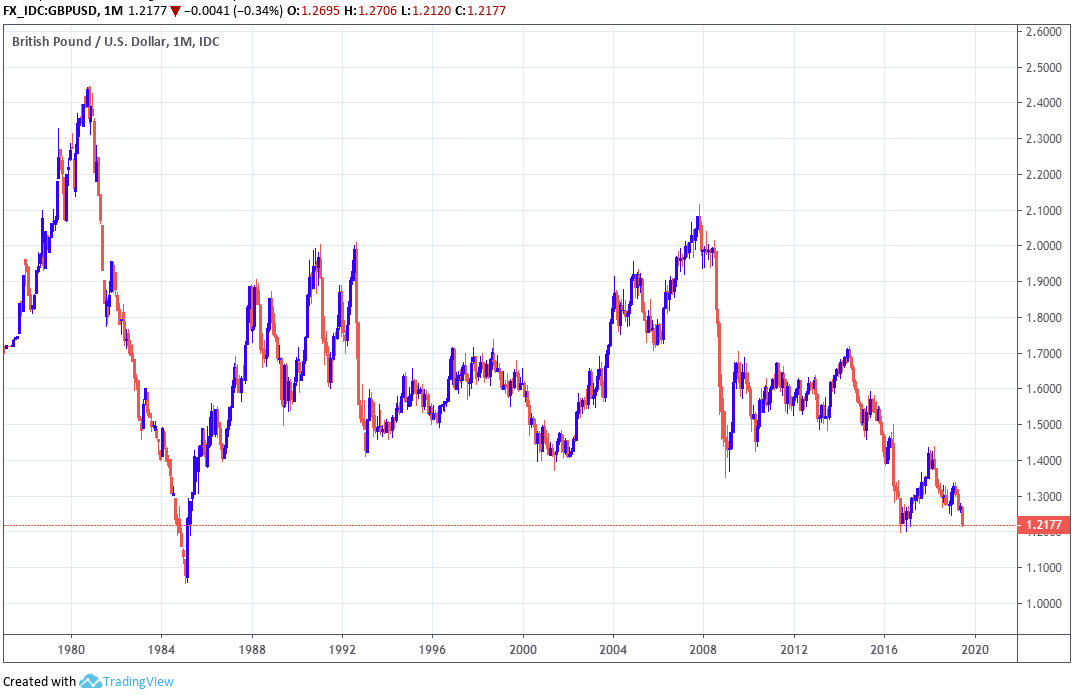Pound-Dollar Rate Slide Not Over Yet, Analysts Say
- Written by: James Skinner
-

© IRStone, Adobe Stock
- The GBPUSD decline is not over yet, say multiple analysts.
- BMO, ING and MUFG all look for more losses this summer.
- Pantheon warns of historic lows for GBP on 'no deal' Brexit.
- GBP selling in Asian trading hours "worrying sign" says BMO.
The Pound slumped even further Tuesday amid a second consecutive declines for the British currency as the markets move to price-in an increased likelihood of a 'no deal' Brexit this Autumn, although multiple analysts say further losses are likely over the coming weeks.
Pound Sterling hit the ropes this week after a minister said the Boris Johnson government is operating under the assumption a 'no deal' Brexit will happen at the end of October, even though Downing Street is also hoping the EU will ultimately give in and remove the so-called Northern Irish backstop from the withdrawal agreement.
"The Prime Minister made clear that the government will approach any negotiations which take place with determination and energy and in a spirit of friendship, and that his clear preference is to leave the EU with a deal, but it must be one that abolishes the backstop," says a Downing Street spokesperson, following a conversation between PM Johnson and his Irish counterpart.
With the EU insisting it won't discuss changes to the agreement it struck with former Prime Minister Theresa May, and Boris Johnson's ministers eschewing any talks with Brussels until the government's conditions are met, financial markets are busy pricing-in an increased threat of a no deal Brexit in October.
This has seen the Pound fall more than 2% this week, which means it has declined close to 4% in the last month alone. Losses for the Pound since its February 2019 peak have now crossed over the 15% threshold but those losses could rise further still if some economists are correct in their calculations.
"Sterling is 13% below the level implied by its past relationship with interest rate expectations," says Samuel Tombs, chief UK economist at Pantheon Macroeconomics. "If the interest rate and foreign exchange markets are broadly in sync, then the 13% risk premium required for a 36% chance of a no-deal Brexit implies that sterling would fall to parity against the dollar, from its current $1.25 level, in the event of a cliff-edge exit."

Above: Pound-to-Dollar rate shown at daily intervals, alongside 2-year UK-U.S. bond yield 'spread'.
Tombs, who's rated by Bloomberg and Reuters as the UK's top inflation forecaster, said Friday the Pound is unlikely to fall as far against the Dollar as the above calculation suggests. He forecasts a Pound-to-Dollar rate of 1.05 if a 'no deal' Brexit happens in October, which would be a record low if the exchange rate falls beneath the 1.0585 level seen January 1985.
Failure to agree terms of exit with the EU before October 31 will automatically result in the UK defaulting to doing business with the EU on World Trade Organization (WTO) terms if parliament if the Prime Minister does not request another Article 50 extension before then. Ratifying the EU withdrawal agreement or an alternative deal could be the only way to avoid such an outcome.
"There are increasing concerns both the EU and UK will not back down and the subsequent collision could lead to a more disorderly No Deal Brexit outcome which would further intensify downside risks for the euro-zone and UK economies," says Lee Hardman, a currency analyst at MUFG. "A retest of the post Brexit referendum low from late 2016 at 1.1841 for cable and high for EUR/GBP at 0.9307 appears increasingly likely over the summer."
Hardman says the Pound would likely fall to 1.10 if the UK leaves the EU without a formal agreement and the Pound-to-Euro rate would fall toward parity. However, and although markets have panicked this week about the seemingly mounting probability of an acrimonious exit, such a thing could yet be avoided.

Above: Pound-to-Dollar rate shown at monthly intervals.
Prime Minister Boris Johnson said Monday that “common sense we will get a deal” and “we will do a grand new deal with the EU based on a new free trade agreement”. And even if the newly-minted leader is wrong, MPs have repeatedly threatened to work together in order to bring down the government if a 'no deal' exit begins to look likely.
"Politics should remain the key negative for sterling in the months to come, with our base case being early elections. This should translate into EUR/GBP heading towards the 0.95 level and GBP/USD falling to 1.18," says Petr Krpata, a strategist at ING Group.
Krpata and the ING team say a general election is now all-but inevitable and that this will likely see the Boris Johnson government pitch a 'no deal' Brexit or some "divisive Brexit stance" to the electorate. But an election would open up another damaging can of worms for the Pound.
With the Labour Party making criticism of government austerity policies the centrepiece of its latest stint in opposition, the UK's main parties could easily find themselves competing to outdo the other's spending pledges.
Such a vote would obviously risk installing opposition leader Jeremy Corbyn in 10 Downing Street, who markets fear almost as much as Brexit, while creating wider scope for another Scottish independence referendum.
"The fact that a lot of today's selling took place during the Asian session is a rather worrying feature of this decline. At the very least, this makes us quite confident that the pair will test lower medium-term levels in the current cycle," warns Stephen Gallo, European head of FX strategy at BMO Capital Markets.










